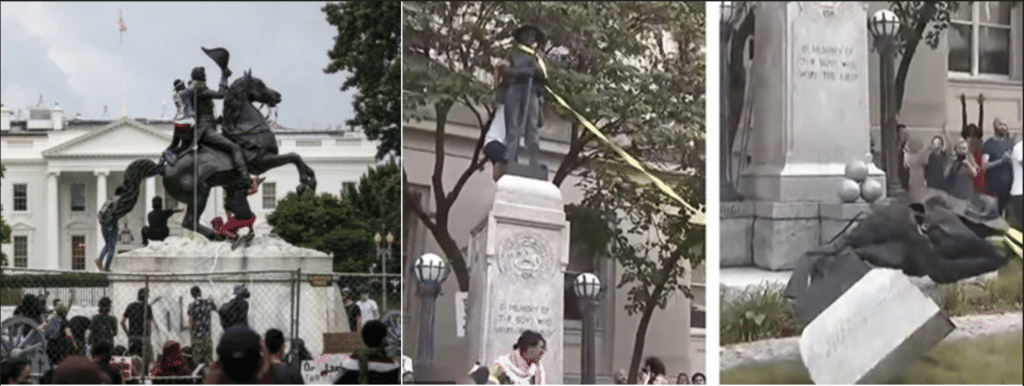
The man stands 12 feet tall, eyes closed in what might be pain or transcendence, chains falling off his outstretched arms, scars striped across his muscled back. Opposite him, a woman on a pedestal cradles an infant and thrusts a document into the air, her face calm and resolute.
With those figures in the forefront, Richmond unveiled a new Emancipation and Freedom Monument on Wednesday — commemorating a far different set of rebels than the Confederate statues that have been coming down for the past year.
Just two weeks after the titanic effigy of Confederate Gen. Robert E. Lee was removed from Monument Avenue, city and state officials dedicated a monument that honors the struggle for freedom and equality by centuries of African Americans.
(The Washington Post, September 22, 2021)
Surely never before in the course of human history has one historic monument replacing another represented so much redemption and symbolized so much hope as this Emancipation and Freedom Monument replacing one to Robert E. Lee does.
But here is how I expressed consternation that it took the infamous killing of George Floyd for monuments like Lee’s to come tumbling down in “To Remove Confederate Monuments … Just Vote!” June 28, 2020:
________

Those monuments have been standing for over 100 years as tributes to the confederacy of traitors who lost the Civil War. As such, they are reminders not just of America’s original sin of slavery, but of the legacy of racism that followed it.
I shall leave it to psychologists to explain why this killing triggered the frenzied tearing down of those statues. But, as I noted in my June 10 commentary, I do not condone this lynch-mob approach. Not to mention that those involved seem more interested in nihilistic grandstanding than in erasing racist taunts.
Simply put, though, it should be as illegal to publicly display Confederate symbols in America as it is to publicly display Nazi symbols in Germany.
________
That said, even in videos and pictures, this monument radiates majesty and soulfulness. Nobody can deny its testament to the triumph and resilience of the human spirit, which now stands in eternal relief to the treason and man’s inhumanity to man the monument to Lee represented.
 This is why I feel obliged to note that the artist who sculpted it, Thomas Jay Warren, is white.
This is why I feel obliged to note that the artist who sculpted it, Thomas Jay Warren, is white.
Blacks like Spike Lee hurled criticisms at director Steven Spielberg for his 1985 film, The Color Purple. In short, Lee argued that, because slavery is not part of his story, Spielberg was not vested enough in telling its truth to risk not making a nickle, which was the case in making his critically acclaimed film about the holocaust, Schindler’s List.
They are hurling similar criticisms at filmmaker Ken Burns for his documentary series on Muhammad Ali, which is now airing on PBS.
But, with all due respect to Lee and others, I do not watch any film or documentary for my truth about history. No one should. For what it’s worth, though, I enjoyed The Color Purple, and I’m convinced Burns is doing as good a job of documenting all that was “bigger than boxing, larger than life” about Ali as any filmmaker could. If you’ve seen Jazz or, perhaps more on point, Unforgivable Blackness, you know what I’m talking about.
So, in addition to the National Museum of African American History and Culture and the MLK Memorial on the Mall in DC, here’s to adding this Emancipation and Freedom Monument on Browns Island in Richmond to your Black pilgrimage.
Related commentaries:
confederate monuments…